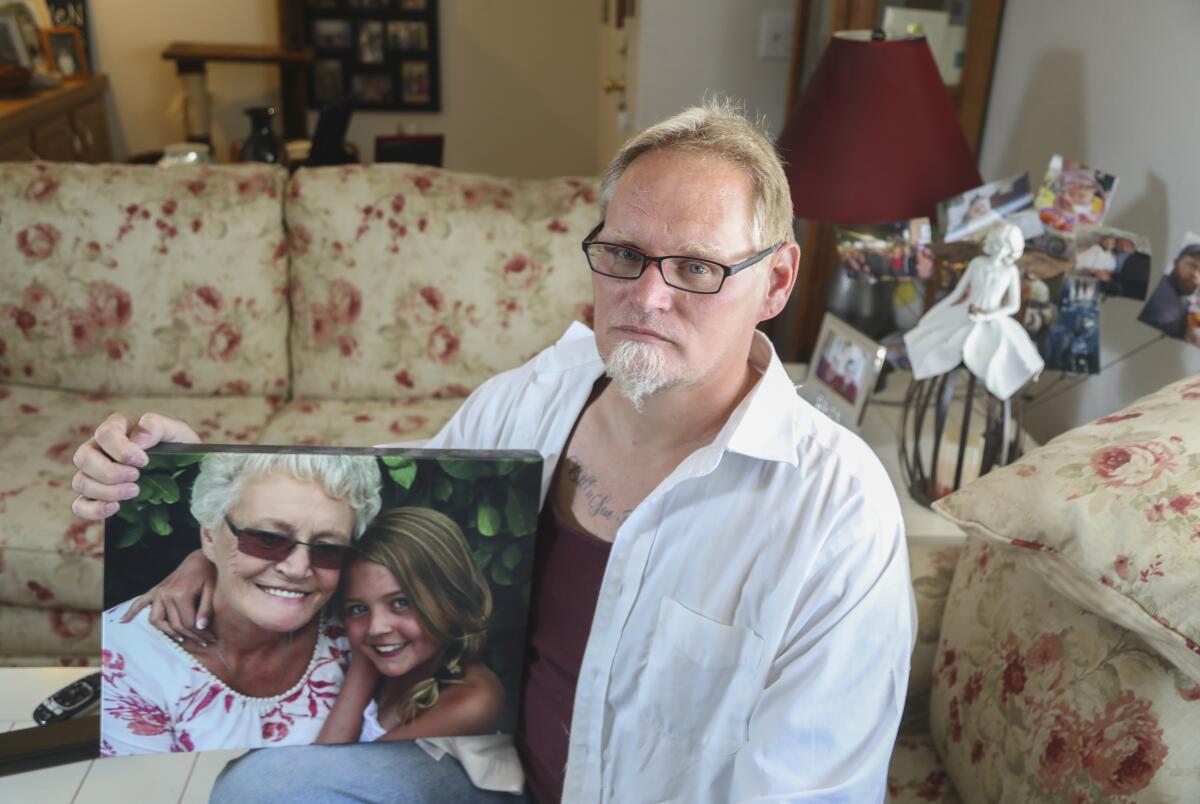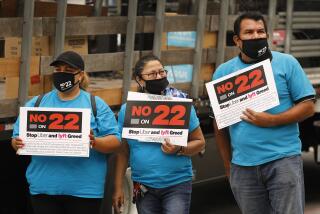A COVID-19 death renews questions of responsibility of Uber and Lyft to drivers

SAN DIEGO — Chuck Beckner begged his 71-year-old mother not to drive for Uber and Lyft during the pandemic. She didn’t listen. Then COVID-19 took Billie Sue Matchke’s life.
“She didn’t deserve that. She was such a good person, such a good mother,” Beckner said, looking at her Toyota Prius still parked in front of the mobile home they shared in El Cajon.
“She didn’t want to be on any life-sustaining equipment,” he added, fighting back tears. “The COVID gave her too much brain damage, so we had the feeding tube taken out.”
The pandemic has dramatically raised the stakes in the years-long fight over what protections Lyft, Uber and other gig-economy companies should be required to provide workers.
Adding to longstanding wage and benefit gripes, Matchke’s fate is now the nightmare scenario facing rideshare drivers everywhere. Some have recently gone beyond just wearing masks and wiping down door handles to also installing makeshift partitions in their vehicles to shield themselves from potentially infected customers.
Advocates have argued that drivers shouldn’t be forced to risk death just to make ends meet, and have blasted Uber and Lyft for making it nearly impossible for drivers to collect state unemployment pay.
“The companies are notoriously greedy,” said Terri Beilke, a San Diego-based driver and volunteer organizer with the advocacy group Rideshare Drivers United. “They have plenty of money, and yet they want to keep risking their drivers’ lives because, I guess, we’re expendable to them.”
Lyft and Uber have long maintained that their drivers should be classified as independent contractors, largely because of the freedom workers have to set their own schedules. As such, the companies have argued that workers have no legal right to protections such as unemployment, overtime and sick leave.
Instead, they have rolled out a variety of programs and policies aimed at quelling health concerns. Those have included offering temporary sick pay for those who test positive for the virus and doling out masks and other personal protective equipment, albeit often at the driver’s expense.
“As people continue to turn to rideshare throughout the COVID-19 crisis, the health and safety of our driver and rider community is our priority,” Lyft said in a statement.
Uber offered a similar response, adding: “The reports of the driver’s passing are heartbreaking and our thoughts are with her family and everyone suffering from this pandemic.”
Matchke worked for more than three decades at the North Island Naval Air Rework Facility on Coronado before retiring. Still, she routinely needed money and had gone through a recent bankruptcy.
At first, driving for Uber and Lyft seemed like the perfect gig to help the sociable Matchke supplement her pension. However, her diabetes complicated the situation when the coronavirus started spreading throughout California.
“I told her, ‘Please, Mom, stop. People are dying,’” Beckner recalled.
Matchke quit driving for a few weeks after the state issued its first stay-home orders in March, but it wasn’t long before she was back behind the wheel. She had applied for unemployment insurance, but like so many rideshare drivers had trouble securing the benefits.
Then around mid-June, Matchke fell ill. First she had a sore throat, but it quickly progressed into coughing and a fever. A few days later, her daughter drove her to the hospital, where it was soon confirmed that she had COVID-19.
Doctors quickly put her on heavy medication and a ventilator, marking the last time Beckner would have a fully coherent conversation with his mother.
“I talked to her on the phone, and I told her, ‘Mom, I love you,” he said. “You’re going to pull through this. You’re a strong woman.’”
She didn’t get better. Eventually, doctors told Beckner that the virus had caused considerable brain damage, and she died in early July.
“It just got worse and worse,” he said, weeping. “She got what’s called COVID brain.”
Carol Butler said she was crushed to hear about her longtime friend. The last time they had gotten together was just a week before Matchke went into the hospital.
“She was walking her dog and she came over to my house, and we talked for like five minutes. That’s the last I saw of her,” Butler said. “I knew about the dangers. You hear about it all the time, but you feel it a lot more when you have somebody close that dies.”
Beckner said the county conducted contact tracing, reaching out to friends and family, but nobody else in their immediate circle was identified as having the virus.
Uber and Lyft have refused to pay into California’s unemployment fund, making it very difficult for the state’s roughly 500,000 drivers to secure such payments in recent months.
“The pandemic has put in stark relief how essential those protections are to workers,” said Ken Jacobs, chair of the Labor Center at UC Berkeley, who’s been closely following the issue.
“They are trying to maximize earnings, minimize costs,” he said of gig-work employers. “It’s what they do as businesses, and it’s up to society and our public institutions to set the parameters within which they work.”
Top state officials have attempted to draw those lines, passing Assembly Bill 5, which went into effect in January. The law puts significant legal pressure on companies to reclassify their workers as employees and provide the associated benefits.
Gig employers have refused to comply. Uber and Postmates challenged the constitutionality of the law in federal court, while Uber, Lyft and others have spent millions on a ballot initiative campaign to sidestep the new law in favor of a suite of industry-designed labor standards.
Proposition 22 will appear on the November ballot; a “yes” vote would exempt the companies from AB 5.
In response, California Atty. Gen. Xavier Becerra and the city attorneys of Los Angeles, San Francisco and San Diego sued Uber and Lyft in May in San Francisco Superior Court. If the plaintiffs win, the companies would not only have to classify workers as employees but potentially pay out hundreds of millions of dollars in back wages and penalties.
“I’m outraged,” said Assemblywoman Lorena Gonzalez (D-San Diego), who was the author of AB 5. “I feel like these companies have been playing a game for years, using delay tactics and courts to put off the inevitable.”
In the meantime, many drivers are struggling to secure unemployment insurance. Gig workers have reported that navigating the state’s bureaucracy can drag on for months, often with no resolution in sight.
To qualify, a driver must first apply for state unemployment insurance. Then the Employment Development Department sends a determination letter based on paperwork filed by Uber and Lyft. Finally, the worker files an appeal and waits for the state to set up an audit to verify proof of income, usually through bank and tax statements.
EDD caseworkers have reportedly encouraged drivers to abandon the process and apply for the federal Pandemic Unemployment Assistance instead. It’s been easier for drivers to qualify for that emergency program, but it’s unclear how long it will last.
This has frustrated labor advocates, who argue gig employers should be footing the bill for such protections, not federal taxpayers. They also point out that state unemployment insurance is often more generous for gig workers because of how benefits are calculated.
Beckner is one of those former drivers trying to navigate the state’s system. He said he’s been waiting for an audit from the state since April.
“I feel that Uber and Lyft should be paying for it because I’m an employee,” he said. “They definitely owe it to me.”
Some drivers have continued to work in recent months despite the health risks. Recently many of them have taken to installing clear partitions in their vehicles to prevent the sharing of germs. That adds to tensions between drivers and companies over who should pay for personal protective equipment.
Uber and Lyft have responded with a patchwork of policies around the issue. Lyft recently caught significant flak for selling such equipment to drivers. Uber has started giving away supplies, prioritizing its busiest drivers.
“Drivers who are already economically crunched should not be economically liable for their own safety equipment,” said Tyler Sandness, a former driver who now works as an organizer with Rideshare Drivers United in Los Angeles. “It really should be the responsibility of the employers to create a safe environment, especially since it’s their customers who are at risk if drivers don’t have adequate access to stuff like that.”
Not all drivers want to be classified as employees. William Dagenhart, who has been driving more than eight hours a day for Lyft in San Diego, recently outfitted his vehicle with a homemade barrier. He downplayed concerns about driving during the pandemic but said the partition helps customers feel more comfortable.
He said he’s happy with his current status. He’s concerned that if he’s an employee he will lose flexibility around where and when he works.
“I like being an independent contractor,” he said. “I’m 100% dedicated to Lyft.”
He also doesn’t think rideshare companies should be forced to pay for unemployment benefits or personal protective equipment such as masks or his new partition.
“It’s not their car, so they shouldn’t have to provide it,” said Dagenhart, 49. “It’s my car. I’m making payments on the car.”
Ricardo Sandoval, 66, made the partition for Dagenhart using a laser cutter he owns for another business. He said he’s now selling the sheets of thermoplastic polymer resin for $60 apiece. They attach to front car seats by threading plastic zip ties through holes cut into the shield.
“It doesn’t cover 100%, but it helps a lot,” said Sandoval, who also drives. “The riders love it.”
Though he uses one in his car, Sandoval said he’s recently reduced his time on the road from about eight hours a day to just a few hours a week. He said he’s very concerned about catching the virus.
Smith writes for the San Diego Union-Tribune.
More to Read
Sign up for Essential California
The most important California stories and recommendations in your inbox every morning.
You may occasionally receive promotional content from the Los Angeles Times.










